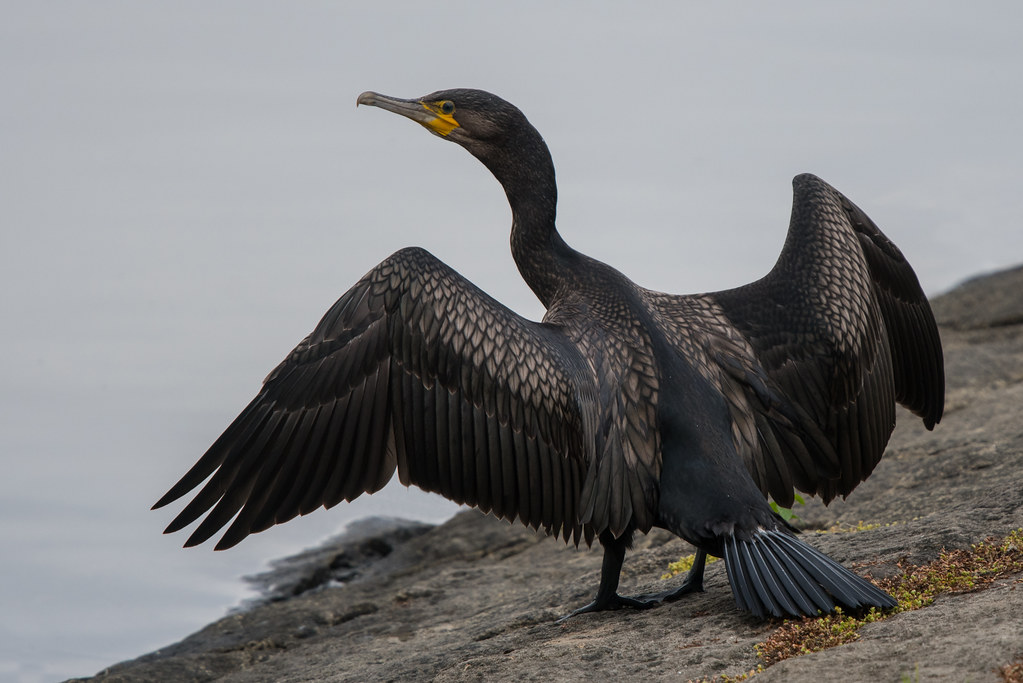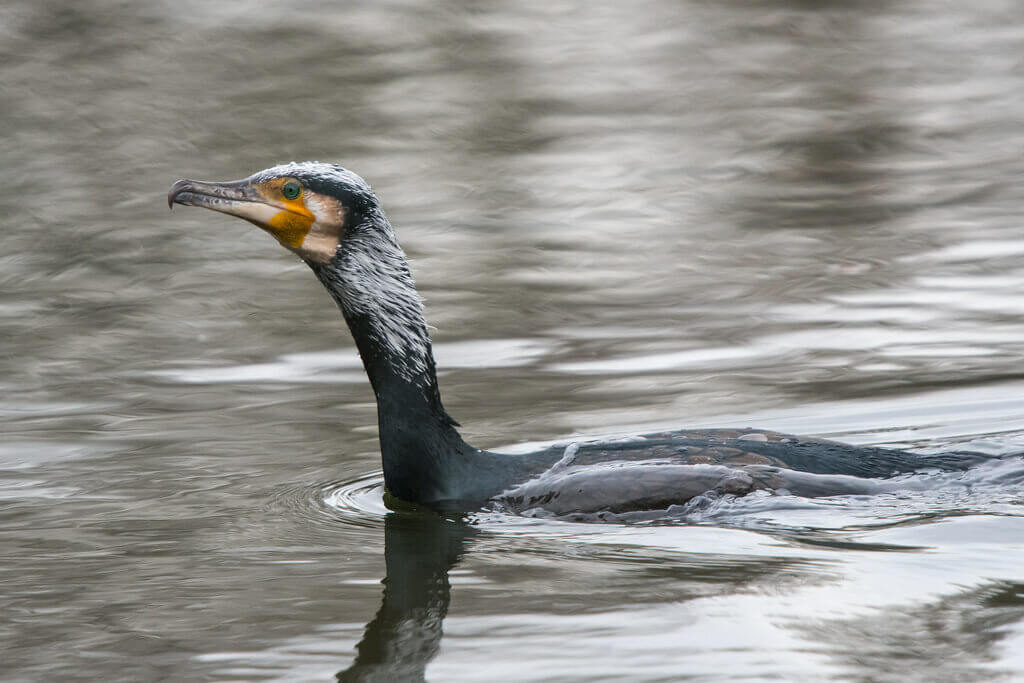
Tim writes: there are a lot of fishing ponds near to where I live which makes Cormorants rather wary. So I was really surprised when this Cormorant continued to dry its wings while I took its photograph. And this was on a stocked lake full of anglers. The microscopic structure of Cormorant feathers makes them wettable which decreases buoyancy and facilitates their ability to pursue fish underwater. But when they emerge they need to dry their plumage.
The name Cormorant dates back to the 12th Century from Old French meaning marine raven. And its scientific name Phalacrocorax translates as bald raven, referring to the skin around the face. And the shape of the bare skin on the face enables me to confidently identify this as the British coastal breeding race “carbo“. On “sinensis” Cormorants (which breed on the Continent and at inland colonies in England) the yellow gape drops at 90° to the bill line creating an obtuse angle (> 90° ) at the rear of the bare-patch whereas on British carbo Cormorants (like this one) there is an acute angle or at most a right angle as this line points forward towards the bill tip. Below is a photograph of a sinensis Cormorant showing the obtuse angle at the rear of the bill, though this one has its white head plumes of the breeding season.

Beautiful photo Tim!
Beautiful birds, and sadly under pressure from habitat loss on the coasts and persecution from the angling community which wants them all culled for the crime of being better fishermen than the anglers.
Great pic of a wonderful bird Tim. Since you mentioned it’s wary of anglers (rumours cormorants are being shot at night at a lowland loch a few miles away from me) thought I’d bring this to your attention – it’s from from the ludicrous Predation Action Group – anglers who don’t like anything that might eat something they could catch. I think it’s a valuable document in that it demonstrates how incredibly ecologically ignorant as well as generally thick too many in the huntin, fishin, shootin set are. It would be side splittingly funny if the consequences of people actually believing such tripe weren’t so serious. Apparently the cormorants that live on freshwater habitats are an invasive species because their subspecific name is sinensis (Chinese) and they flew here from the continent! Birds flying across national boundaries without permission, how bloody outrageous! https://50ddf6cf-3591-4775-b0fc-543d75a0aa5f.filesusr.com/ugd/d64b93_b92118d45e1c4496bdca09acf3b502b5.pdf
Thanks Les. I was told that a local water-keeper (I think this is the anglers’ equivalent of a gamekeeper) had a licence to kill 12 Cormorants in a year, but he boasted in the pub to his friends that he kills dozens, because each time he returns his tally resets to zero, because nobody checks.
And being able to get a licence to kill cormorants opened the door to do the same with buzzard. Rumour that the heron at local trout fishery less than a mile from my front door was shot, hope the owners don’t find out about the otter! I don’t think the ecological damage and anti predator bilge from the mainstream angling community is getting anywhere near the attention it deserves (the Angling Trust is becoming the most prominent anti beaver voice in England as other groups become more progressive). It’s very noticeable how many of the trolls on Chris Packham’s Facebook page are anglers, carp anglers particularly, and the idea that otters are an over protected species that is now killing off other wildlife and needs to be ‘controlled’ is cropping up more and more in the public sphere after being pushed by this lot. I believe the conservation organisations need to join together to fight this trend which is encompassing a wider and wider range of species on an ever wider front – buzzards and raven have been killed with official sanction, but zero justification, but who is really flying the flag for the pine marten’s contribution to red squirrel conservation by eating the grey ones?
There is a certain “Rivers Trust” on the west of Scotland that regularly talks up the supposed “damage” that cormorants do to salmon parr on their facebook page, and seems to tacitly encourage other contributors to talk about killing them. They also, despite being a supposed conservation charity, actively teach angling lessons in schools as part of their ecology education remit, claiming it is the best way to teach children about river life. It is truly vile.
As someone pointed out to me the biggest predator on the salmon is probably the brown trout! That’s something I like mentioning to the let’s cull them lobby. I wasn’t entirely surprised that once upon a time some rivers were netted to take out trout to help the salmon! It’s shocking how idiotic and destructive the huntin, fishin, shootin set have been. There’s an outfit up north that’s remit is to deal with invasive species that has slipped angling into its work too. There’s precious little evidence that angling is a good pathway to an interest in natural history or conservation, I didn’t see any when I was a keen angler.
That sounds about right Tim…at one time corpses were retrieved for analysis [Mick Marquiss?] but just like licences to kill other bird species in the UK, monitoring is woeful or non-existent. Ravens area case in point, Ive been told of over a hundred being killed on a “bag licence” for 6. Once you give out a licence its pretty much an open invitation to slaughter.
It’s a very delicate issue within angling, and one that angrily divides anglers themselves. I have personally witnessed the extent of impact that cormorant predation can have on inland waterways. A private estate lake in Hampshire (where I grew up) which was chalk-stream fed, and therefore clear and shallow, but had an extraordinary population of roach. A flock of ‘many score’ of cormorants (sinensis) overwintered and all but cleared the lake of the roach. I visited the following year and saw no sign of any fish, although some would have remained.
In time of course, the population should recover, but people are not naturally attuned to long term trends. Instead, they panic whenever there is a local, short-term issue and more often than not, lose all sense of perspective.
My own feeling is, by and large, to leave nature to find its own balance, but do appreciate the concern that is felt when a ‘new’ predator makes a mark. The cormorant issue has not been handled well, but there is reasonable argument that the presence of large flocks of birds can have significant impact upon local fish populations. This is typical behaviour of sinsensis, but with traditional wintering grounds in south-central Europe suffering long-term from diminished fish stock, the large congretations have ventured increasingly inland. Large numbers first began appearing on some of the large river systems in central Europe, which had often been canalised, straightened and deepened for shipping, therefore creating perfect hunting grounds for the cormorant.
Our tendancy for neat lines and manicured landscapes removes the obstacles that both deter the cormorants (who need a low trajectory to land and take-off) and provide shelter for fish. Of course, people rarely consider this and instead blame the cormorant. A sentiment compounded, sadly, by the proclamations of those in positions of influence who really should know better. Hence the misconceptions surrunding the status of sinensis in the UK – which certainly isn’t ‘invasive’ and seems to have bred here to some extent for many centuries.
The tub-thumping ends up getting silly, and I’ve seen one very well known angler suggest that a 3000 annual limit on culled cormorants be increased tenfold – which would pretty much equal complete eradication. Such comments make anglers seem, quite frankly, stupid – when many have legitimate concerns that get lost in the sensationalisation.
A further problem comes with calls for restocking of fish, which again, are often made by anglers who have a large platform to shout from. The stocking into a river that has a specifically evolved ecosystem, with thousands of fish that have been reared in tanks, is literally compounding a problem. These are fish without any natural instinct or genetic moulding to the specific environment – and obviously, the cormorants (and other predators) find an easy, and unnatural food source that Man keeps topping up.
Sorry – I’m rattling on a bit – suffice to say that there are an awful lot of anglers who have a good understanding of ecosystems and predator presence. Unfortunately, their voices are normally drowned out – and rather than address the real issues facing our rivers (lack of natural recruitment, lack of invertebrate life, water quality and clarity, excess abstraction, nitrate and phosphate levels, agri run-off, siltation, etc, etc) we end up bickering endlessly about cormorants.
The cormorant, like the heron, osprey, and otter, are the anglers friend. They show where the fish are. If you are casting all day in a lake with cormorants taking fish and not catching anything, then the reason is not the cormorants, it is the lack of fishing ability. If there were no fish to eat, the cormorants would not be there. Trouble is that a lot of anglers can only manage to catch anything when there is a superabundance of prey fish (the metaphorical fish in the barrel), but are too arrogant and cocksure of themselves to admit it. Thus they blame the more visible fauna.
I’ve always said that if there was, as a precondition to any cull, the requirement that fishing cease on that body of water for every year a cull was carried out, that need for them would dry up in an instant. If the natural population is so fragile that there needs to be a cull to protect it, then it ought to be too fragile for angling pressure too.